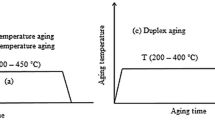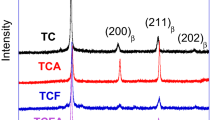Abstract
Stemming from their unique combination of elevated strength, low density, and good overall corrosion resistance, beta titanium alloys have become attractive candidate materials for critical, high-stress components in corrosive services. An overview of the comparative corrosion resistance of beta alloys to conventional alpha and alpha/beta titanium alloys in common industrial and aerospace service environments generally reveals attractive behavior depending on the environment and alloy composition and, in some cases, alloy condition. Expanded performance windows are especially noted for the molybdenum-rich beta alloys, particularly with regard to resisting reducing acids, stress corrosion, and high-temperature localized chloride attack, along with hydrogen and oxidation resistance. Where applicable, implications of this enhanced corrosion performance on current and perspective beta alloy applications are also noted.
Similar content being viewed by others
References
D.R. Klink and R.W. Schutz, “Engineering Incentives for Utilizing Ti-3Al-8V-6Cr-4Zr-4Mo Titanium Tubulars in Highly Aggressive Deep Sour Gas Wells” (Paper no. 63 presented at NACE Corrosion’ 92, Nashville, TN, 27 April–1 May 1992).
D. Dunlap and R.W. Schutz, “Utilization of Beta-C Titanium Components in Downhole Service” (Paper presented at the 122nd TMS Annual Meeting, Denver, CO, 21–25 February 1993).
W.W. Love et. al., “The Use of Ti-38644 Titanium for Downhole Production Casing in Geothermal Wells,” Sixth World Conference on Titanium Proceedings (Les Ulix, France: Societe Françcaise de Metallurgie, 1988), pp. 443–448.
K. Faller and W. Edmonds, “The Incentives for Titanium Alloy Fasteners in the Navy/Marine Environment” (Paper presented at the 1991 Ship Maintenance in the 21st Century Symposium, Virginia Beach, Virginia, 21–22 February 1991, American Society of Naval Engineers, Alexandria, VA
Metals Handbook, 9th edition, vol. 13, “Corrosion” (Materials Park, OH: ASM International, 1987), pp. 669–706.
R.W. Schutz and J.S. Grauman, “Fundamental Characterization of High-Strength Titanium Alloys,” Industrial Applications of Titanium and Zirconium (Philadelphia, PA: ASTM, 1986), pp. 130–143.
R.W. Schutz and M. Xiao, “Enhancing Corrosion Resistance of the Ti-3Al-8V-6Cr-4Zr-4Mo Alloy for Industrial Applications” (Paper presented at the Seventh World Conference on Titanium, San Diego, CA, June 1992).
R.W. Wood, Beta Titanium Alloys, Report #MCIC-72-11, Metals and Ceramics Information Center (Columbus, OH: Battelle-Columbus Laboratories, September 1972).
M. Stern and C. Bishop, “The Corrosion Resistance and Mechanical Properties of Titanium-Molybdenum Alloys Containing Noble Metals,” Transactions of the ASM, 54 (1961), p. 287.
R.W. Schutz and J.S. Grauman, “Compositional Effects on Titanium Alloy Repassivation Potential in Chloride Media,” Advances in Localized Corrosion, pp. 335–337.
R.W. Schutz, M. Xiao, and J.W. Skogsberg, “Stress Cracking and Crevice Corrosion Resistance of Pd-Enhanced Ti-38644 Titanium Alloy Products in Deep Sour Gas Well Environments” (Paper presented at the 12th International Corrosion Congress, Houston, TX, September 1993).
J.S. Grauman, “Beta-21S: A New High Strength, Corrosion-Resistant Titanium Alloy,” Proceedings of the Technical Program from the 1990 International Conference (Boulder, CO: Titanium Development Association, 1990), p. 290.
M. Ueda et al., “Corrosion Behavior of Titanium Alloys in a Sulfur-Containing H2S-CO2C1-Environment,” Paper No. 271 (Paper presented at the NACE Corrosion’ 90 Conference, 23–27 April 1990, Las Vegas, NV).
Stress-Corrosion Cracking—Materials Performance and Evaluation (Materials Park, OH: ASM, July 1992), pp. 265-297.
R.J.H. Wanhill, “Aqueous Stress Corrosion in Titanium Alloys,” Br. Corros.J., 10(2) (1975), pp. 69–78.
R.P. Gangloff et al., “Environmentally Assisted Cracking of High Strength Beta Titanium Alloys,” Annual Report —GrantNo.N0014-91-J-4164,SEASReportNo.UVA/525464/MSE93/101, (Charlottesville, VA: University of Virginia, October 1992).
L.M. Young, “Environment Assisted Cracking in β-Tita-nium Alloys” (Paper presented at the 122nd TMS Annual Meeting, Denver, CO, 21–25 February 1993).
I. Azlcarate and A. Pelayo, “Hydrogen Assisted Stress Cracking of Titanium Alloys in Aqueous Chloride Environ ments” (Paper presented at the INASMET Conference, San Sebastian, Spain, 1992).
D.M. Aylor, “A Hydrogen Embrittlement Evaluation of High Strength, Non-ferrous Materials for Fastener Application” (Paper presented at the Naval Surface Warfare Center, Annapolis Detachment, Carderock Div., Code 2813, Annapolis, MD, 1992).
L.H. Wolfe et al., “Hydrogen Embrittlement of Cathodi-cally Protected Subsea Bolting Alloys,” Paper No. 288 (Paper presented at NACE Corrosion’ 93 Annual Conference, Houston, TX, 1993).
B. Bavarian, “Corrosion Behavior of Beta-21S Ti Alloy In Chloride-Containing Environments” (Paper no. 284 presented at NACE Corrosion’ 93, Houston, TX, 1993).
D.E. Thomas and S.R. Seagle, “Stress Corrosion Cracking Behavior of Ti-38-614 in Sour Gas Environments,” Titanium Science and Technology (Munich, Germany: Deutsche Gesellschaft fur Metallkunde, E.V., 1984), pp. 2533–2540.
R.W. Schutz, M. Xiao, and T.A. Bednarowicz, “Stress Corrosion Behavior of the Ti-3Al-8V-6Cr-4Zr-4Mo Titanium Under Deep Sour Gas Well Conditions” (Paper no. 51 presented at NACE Corrosion’ 92, Nashville, TN, 27 April-1 May 1992).
S. Kitayama et al., “Effect of Small Pd Additions on the Corrosion Resistance of Ti and Ti Alloys in Severe Gas and Oil Environment” (Paper no. 52 presented at NACE Corrosion’ 92 Annual Conference, Houston, TX, 1992).
W.F. Cyrklis and M. Levy, “Stress Corrosion Cracking Susceptibility of β Titanium Alloy 38-6-44,” Corrosion, 32(3) (March 1976), p. 99.
R.W. Schutz and M. Xiao, “Stress Corrosion Cracking Behavior of Ti-38644 Titanium Alloy Products in Methanol Solutions” (Paper No. 148 presented at NACE Corrosion’ 93, Houston, TX, 1993).
H.-E. Krugmann and J.K. Gregory, Microstructure/Property Relationships in Titanium Alloys and Titanium Aluminides, ed. R.R. Boyer and Y. Kim (Warrendale, PA: TMS, 1991).
G.R. Yoder et al., “Corrosion-Fatigue Resistance of Ti-10V-2Fe-3Al Alloy in Salt Water,” Sixth World Conference on Titanium Proceedings (Les Ulix, France: Societe Française de Metallurgie, 1988), pp. 1741–1746.
N.E. Paton and J.C. Williams, “Effect of Hydrogen on Titanium and Its Alloys,” Titanium and Titanium Alloys—Source Book (Materials Park, OH: ASM, 1982), pp. 185–207.
J.E. Costa et al., “Hydrogen Effects in β-Titanium Alloys,” Beta Titanium Alloys in the’ 80s (Warrendale, PA: TMS, 1984), p. 69.
G.A. Young and J.R. Scully, “Effects of Hydrogen on the Mechanical Properties of a Ti-Mo-Nb-AI Alloy,” Scripta Metallurgica, 28 (1993), pp. 507–512.
J.R. Wood and M.L. Bogensperger, “Effects of Hydrogen On the Structure and Properties of Beta-CTM(Ti-38644) Sheet,” Proceedings of the Seventh World Conference on Titanium (San Diego, CA, June 1992).
H.G. Nelson, “Hydrogen-Induced Ductile-to-Brittle Fracture Transition in Beta Titanium Alloys,” Proceedings Summary of the 5th Workshop on Hydrogen-Material Interactions, NASP Workshop Publication (April 1993).
D.S. Schwartz, “Effect of Internal Hydrogen on Micro-structure and Mechanical Properties of Beta-21S and Ti-15-3” (Paper presented at the 122nd TMS Annual Meeting, Denver, CO, 21–25 February 1993).
B. Bavarian et al., “High Temperature Corrosion behavior of Beta-21S Titanium Alloy” (Paper no. 243 presented at the NACE Corrosion’ 93 Annual Conference, Houston, TX, 1993).
P.J. Bania and W.M. Parris, “Beta 21-S: A High Temperature, Metastable Beta Titanium Alloy,” (Presented at the TDA 1990 International Conference on Titanium Products and Applications, Orlando, FL).
Z. Liu and G. Welsch, Metallurgical Transactions A, 19A (April 1988), p. 1121.
W.M. Parris and P.J. Bania, “Oxygen Effects on the Metallurgical Properties of TIMETAL® 21S” (Presented at the Seventh World Conference on Titanium, San Dieeo, 1992).
T.A. Wallace, R.K. Clark, and K.E. Wiedemann, “Oxidation of Beta-21S in Air in the Temperature Range 600 to 800°C,” Proceedings of the Seventh World Conference on Titanium (Warrendale, PA: TMS and Boulder, CO: Titanium Development Association, 1992).
K.E. Wiedemann et al., “Mechanical Properties of Coated Titanium Beta-21S After Exposure to Air at 700 and 800°C,” NASA Technical Memorandum 104220 (June 1992).
V.G. Anderson and B. A. Manty, “Titanium Alloy Ignition and Combustion,” Report No. NADC 76083-30 (West Palm Beach, FL: United Technologies Corp., Pratt & Whitney Aircraft Group, January 15,1978).
D.M. Berczik, “High Strength Nonburning Beta Titanium Alloys,” U.K. Patent Application No. GB 2238057A (May 22, 1991).
P. Krag and R. Henson, “An Ignition Resistant Titanium Alloy for Acid Pressure Oxidation Applications,” Proceedings of the RANDOL Gold Forum (Vancouver, Canada: Randol, 1992), p. 201.
Author information
Authors and Affiliations
Additional information
Editor’s Note
The following article is distilled from a presentation delivered at the International Workshop on Beta Titanium Alloys, sponsored by the French Metallurgical and Materials Society. For information on the proceedings, which are scheduled for publication at the end of the summer, contact the society at 1, Rue Paul Cézanne, 75008 Paris.
Rights and permissions
About this article
Cite this article
Schutz, R.W. Environmental behavior of beta titanium alloys. JOM 46, 24–29 (1994). https://doi.org/10.1007/BF03220744
Issue Date:
DOI: https://doi.org/10.1007/BF03220744




